FOREX-Euro and pound inch up as growth optimism cheers investors - Reuters
FOREX-Euro and pound inch up as growth optimism cheers investors - Reuters |
- FOREX-Euro and pound inch up as growth optimism cheers investors - Reuters
- Year In Review: What Shaped FX In 2019 - Investing.com
- End-Of-Year USD Selloff Drives FX - Investing.com
| FOREX-Euro and pound inch up as growth optimism cheers investors - Reuters Posted: 31 Dec 2019 01:25 AM PST * Dollar loses ground against most currencies * Australian dollar best outperforming G10 currency overnight * Graphic: World FX rates in 2019 tmsnrt.rs/2egbfVh By Olga Cotaga LONDON, Dec 31 (Reuters) - The euro and the British pound rose as the dollar weakened on Tuesday as investors saw global growth improving next year, with the United States and China due to finally sign a Phase 1 trade agreement this week. The U.S. currency had maintained its strength over the course of the year as investors saw the U.S. economy outperforming the rest of the world. In thin volumes on the last day of the decade, currencies overall were more volatile than many expected, with the trade-sensitive Australian dollar, Chinese yuan and Scandinavian currencies all rising to their highest levels in weeks. Sterling hovered around the two-week high it hit on Monday against the dollar, though the possibility of a 'no-deal' Brexit at the end of 2020 kept any gains subdued. Still, analysts did not attribute the moves to any major particular developments. "I can't see much reason for the movement in the FX market except end-year position squaring, or just being careful and cutting positions ahead of the New Year's holiday and the start of 2020. As a result I wouldn't draw any big conclusions from it," said Marshal Gittler, currency analyst at ACLS Global. Chinese Vice Premier Liu He will visit Washington this week to sign a Phase 1 trade deal with the United States, the South China Morning Post reported on Monday. White House trade adviser Peter Navarro said on Monday the trade deal would likely be signed in the next week, but that confirmation would come from President Donald Trump or the U.S. trade representative. Investors' appetite for risk helped drive the euro up 0.1% to $1.1206, close to the 4-1/2-month high of $1.1221 reached on Monday. Signs that the euro zone economy may be stabilising have lifted the single currency in recent weeks as investors unwound short positions, though the currency has shed 2.2% of its value against the dollar in 2019. Latest CFTC data shows that hedge funds held $9.16 billion of euro shorts, far less than the $14.84 billion seen in May. The U.S. dollar was weak across the board, though over the course of the year, the index that tracks the dollar against a basket of six currencies has risen by half a percentage point . MUFG analysts saw a "bearish technical development for the U.S. dollar that signals an increasing risk of further weakness ahead". "Weakness in the U.S. dollar towards the end of this year has coincided with the renewed expansion of the Fed's balance and the paring back of pessimism over the outlook for global growth," they said. Versus the Japanese yen, the dollar fell to a near three-week low of 108.625 yen and was last down 0.2%. Against the Chinese yuan, it shed 0.2% to 6.9674 in the offshore market after dipping to a 2-1/2-week low of 6.9630, as strong Chinese economic data helped boost the Chinese currency. The Australian dollar rose to a five-month high of 0.7310 versus the U.S. dollar, making it the best performing major currency overnight, according to MUFG. The New Zealand dollar, however, "remains the stand out performer of the last quarter, surging nearly 8% over the past three months, largely on the back of more positive sentiment about global trade", MUFG analysts said. Scandinavian currencies also strengthened against the greenback following all-time lows seen this year on the back of global growth fears sparked by U.S.-Chinese trade disputes. The pound was up 0.3% at $1.3144, close to the $1.3150 high seen on Monday, and a notch stronger against the euro at 85.41 pence. Sterling has gained nearly 3% against the dollar and 5% versus the euro this year, jumping to as high as $1.35 recently after Prime Minister Boris Johnson's overwhelming win in a parliamentary election, which eliminated a measure of uncertainty. Reporting by Olga Cotaga Our Standards:The Thomson Reuters Trust Principles. |
| Year In Review: What Shaped FX In 2019 - Investing.com Posted: 30 Dec 2019 01:41 PM PST Daily FX Market Roundup 12.30.19By Kathy Lien, Managing Director of FX Strategy for BK Asset Management2019 has been a busy year for the financial markets. The biggest driving forces were trade war, global easing, Brexit and record breaking moves in US stocks. Hong Kong dissolved into political chaos and President Trump became the third President in the history of the United States to be impeached by the House. One would expect that these political developments would have made investors nervous and drive stocks lower but all of the major indices across the globe enjoyed gains. In the US, the rose more than 20%, the is up nearly 30%, the is up 25%, is up more than 12%, the i gained 19% and despite all of China's troubles, the rose 20%. However the consistency in equites was not seen in currencies.2019 was a good year for the and and a challenging one for the euro. All other major currencies changed little in value versus the greenback. The first 9 months of the year was actually kind to the dollar. There was a lot of choppiness in the greenback but the overall trajectory of the was higher. However at the end of September into early October, DXY peaked and trended lower into year end. There were 2 primary drivers for the greenback this year – the trade war and the Fed. The trade war has been good for the dollar for no reason other than the fact that tariffs are more painful for the rest of the world than for the US so the dollar benefited from safe haven flows. China ended the year with higher tariffs. In May 2019, the US increased tariffs from 10% to 25% on USD$200B worth of Chinese goods. China responded with their own increased tariffs on US$60 billion worth of goods. Then on September 1st, the US implemented higher tariffs on another USD$125B worth of Chinese imports. In October the US announced a Phase 1 deal that would delay tariff increases that were set to go into effect in October but the US and China oscillated between progress and setback before reaching a trade truce that delayed the December tariffs. A signing ceremony is expected in the New Year but when it comes to US-China trade relations, until the ink meets the paper, attitudes could change on a dime. The Federal Reserve lowered interest rates 3 times in 2019 but easing did not begin until June so for the first 6 months of the year, trade tensions and steady US policy helped to boost the dollar. The Fed cut rates and the dollar fell but the losses were shortlived because the central bank described the moves as insurance against a deeper slowdown. However in October, US data started to take a turn for the worse and the greenback peaked. Then in December, the Fed dot plot changed and central bankers forecasted unchanged rates for 2020. Chairman Powell's emphasis on low rates for long helped to drive stocks higher but took the air out of the dollar rally. The Fed was not the only central bank to ease monetary policy in 2019. The Reserve Bank of Australia and Reserve Bank of New Zealand cut interest rates by 75bp each while the European Central Bank cut rates on bank reserves for the first time since 2017 and restarted Quantitative Easing. The Bank of Canada, Bank of England, Bank of Japan and Swiss National Bank made no changes to monetary policy which explains why the Canadian dollar and British pound were this year's best performing currencies.  Global FX As we draw 2019 to a close, the most influential events that shaped FX was policy uncertainty and the cycle of global easing. Unfortunately much of this uncertainty persists into 2020. Assuming that a Phase 1 trade deal is signed, what happens next? The Phase 1 deal is a modest one – China didn't give up much and in exchange got Trump to delay tariffs. With the 2020 elections nearing, the US President could get tough on China once again. Boris Johnson won big in the UK but he's still willing to leave the European Union without an agreement. FX volatility also compressed significantly with 3 month euro vols hitting record lows. This could be a structural shift but with the US election next year and the risk of stocks coming off their highs, leading to broad based profit taking, we expect volatility to rise in 2020. |
| End-Of-Year USD Selloff Drives FX - Investing.com Posted: 30 Dec 2019 10:16 AM PST Friday's and the selloff continued into Monday's trade. were down nearly another 0.4% in U.S. trading as the dollar looked to test the spike-lows from the Christmas Eve. Price is diverging on a short-term time frame, however, year-end flows will dominate and technicals won't be as relevant if people need to get things done before year's end. 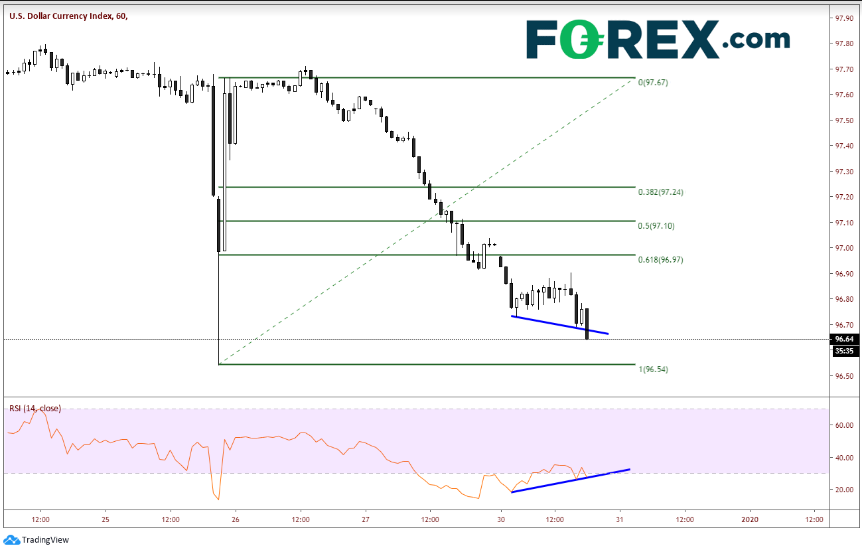 Hourly USD Source: Tradingview, FOREX.com Even though technicals may not be as important when funds need to get things done, it is still important to look for areas where price may pause or reverse. DXY is well underneath the upward channel it has been in since mid-2018. If DXY breaks through recent spike lows, the next level is the 50% retracement level from the June 2018 lows to the highs on September 30th of this year at 96.43. Below that is a zone for support between the 61.8% retracement of the same time period and horizonal support, between 95.66 and 95.84. Resistance is back at the upward sloping channel line near 97.50. 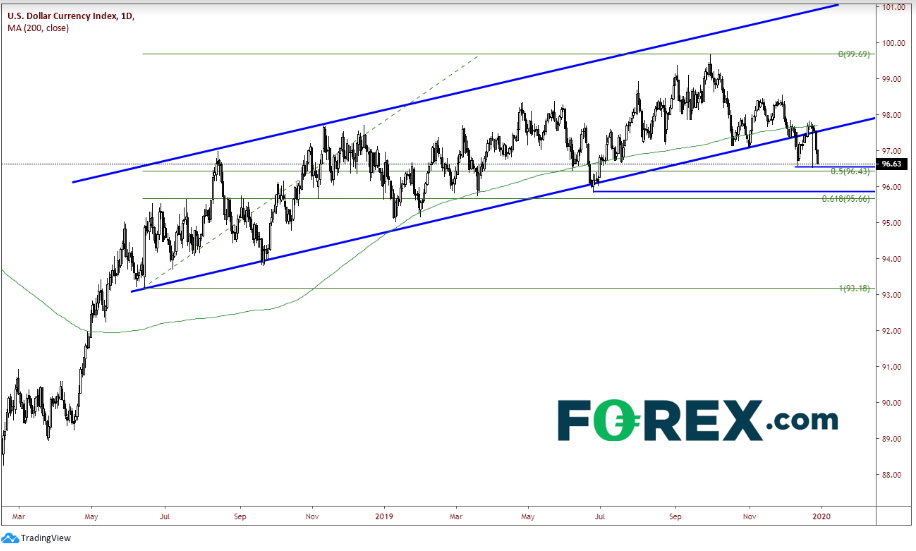 Daily USD Source: Tradingview, FOREX.com As a result, many of the U.S. dollar counter currencies are continuing to trade higher. has broken decisively above 1.1200 and the 61.8% retracement level from the June highs to the September 30th lows at 1.1207. If this move continues, price can easily run up to 1.1350. 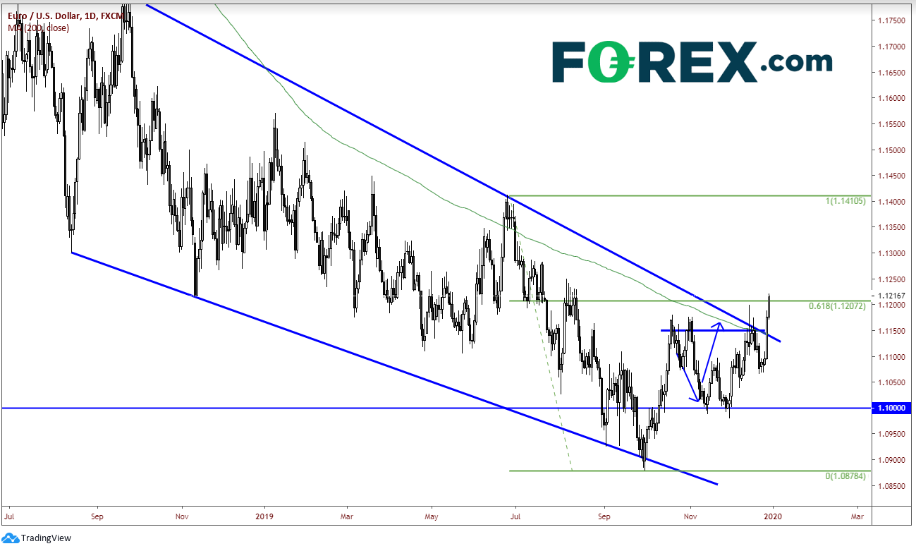 Daily EUR/SUD twice failed to take out the 61.8% retracement level from the April 25 highs to the august 12 lows and put in a double top. Price is moving towards the target of the double top near .9640 and well as the August 12 lows near .9663. 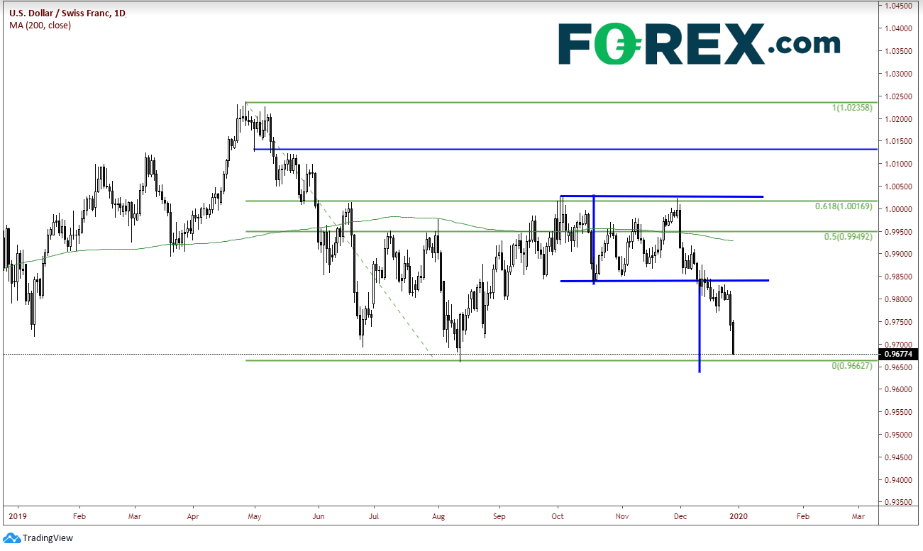 Daily USD/CHF Source: Tradingview, FOREX.com Commodity currencies have been hit as well vs the U.S. dollar, with being on of the hardest hit over the last few weeks. The bid is the Norwegian Krone has been hit by a double whammy of a weak U.S. dollar and strong . Price has fallen from a high of 9.1846 on December 12 to current levels near 8.7894. Along the way, and pair has broken the 200-day moving average, horizontal support and the 61.8% retracement of the move from the low on July 19th to the highs on December 12. The RSI is in oversold territory. 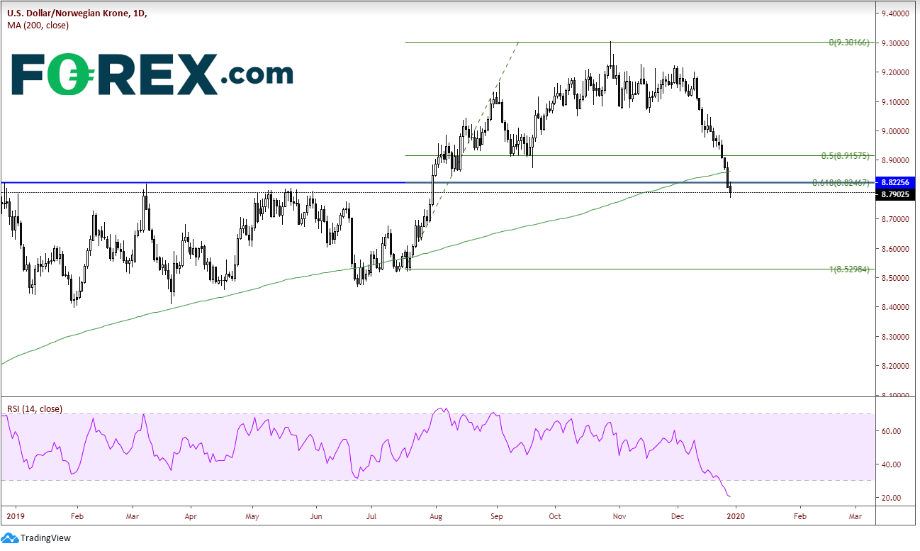 Daily USD/NOK Source: Tradingview, FOREX.com Note the , and dollars are also testing recent highs versus the USD as well. It is important to remember that until the market reopens January 2, these appear to be year end flows. Many of the U.S. dollar moves continue to be exaggerated. The technicals mentioned here will become more useful once we enter the new year. |
| You are subscribed to email updates from "investing forex" - Google News. To stop receiving these emails, you may unsubscribe now. | Email delivery powered by Google |
| Google, 1600 Amphitheatre Parkway, Mountain View, CA 94043, United States | |
Comments
Post a Comment